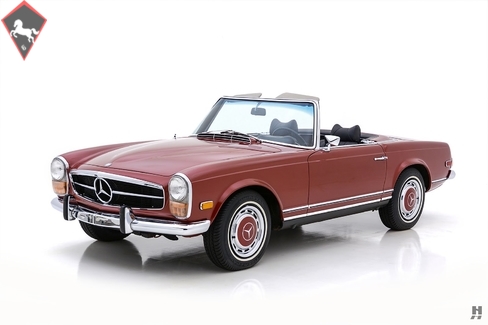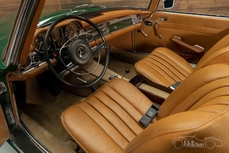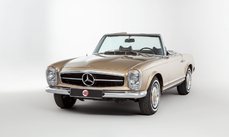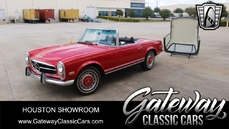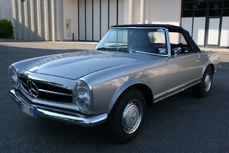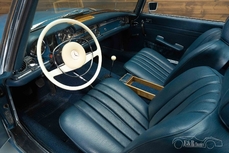Mercedes-Benz 280SL w113 1971
General description :
As production of the 300 SL and 190 SL came to a close in the early 1960s, Mercedes-Benz took the opportunity to reinvent the entire concept of the SL line of sports cars with the new W113, introduced in 1963. Like the 190 SL before it, the new 230 SL chassis shared standard components with the contemporary sedan line to costs in check. Paul Bracq and his team designed a beautiful, minimally-adorned body with crisp lines and exquisite detail. From the onset, the car was designed as a roadster with a removable hardtop, which featured a subtle concave top panel earning it the nickname “Pagoda.” On introduction, the new SL was a sports car like no other on the market. It combined the open-air experience of a traditional roadster with the insulated comfort and practicality of a continental GT cruiser. It was built with typical Mercedes quality and delivered impressive performance in a refined and understated package. The “Pagoda” SL evolved through three generations: The 230 SL, 250 SL, and 280 SL which rant through 1971 with the arrival of the new R107 chassis.
The final evolution of the W113 appeared in 1968 with a bored/stroked 2.8-liter version of the robust Bosch-injected inline-six. A manual gearbox was available, yet the vast majority of cars left the factory gates equipped with the four-speed automatic transmission, which best suits the 280SL’s relaxed GT-like demeanor. The press criticized early models for lack of power, but thanks to the abundant torque and 170hp output of the 280 SL, those criticisms were effectively silenced. Handling is surefooted and capable, striking a fine balance between ride comfort and cornering grip via the independent front and swing-axle rear suspension. The W113 is certainly less aggressive than other traditional sports cars, yet it is surprisingly capable when the going gets twisty. Equally at home on a cross-continental journey as it is hustling along sweeping back roads, the 280 SL is a sophisticated, elegant sports car for the enthusiast of more refined tastes.
This highly desirable, late-production 1971 280 SL is a superb, unrestored example and one of the finest of its kind we have had the pleasure to offer. Recently out of long-term ownership, this car spent many years carefully preserved in an extensive collection of significant sports cars. It presents in its original color combination of metallic red (Code 571H) over a black MB-Tex interior (Code 131) with a matching color-keyed hardtop, and a black soft-top (Code 740). An original US-spec car, this Pagoda came well-equipped from new with power steering, automatic gearbox, Becker Europa radio, heated rear glass and the optional side-facing jump seat. It is believed that the metallic red paint is nearly all original, and it presents in outstanding condition with beautifully crisp lines and exceptionally straight panels. There is a small amount of checking in the hardtop paint, while the remainder of the body is excellent. Gaps are consistent, and the doors close with the positive vault-like feel that defines Mercedes-Benz quality of the era. Importantly, the subtle “notches” where the fenders meet the headlight trims are still perfectly visible, as are the factory welds, both critical elements of unmolested body and paintwork on a W113. Exterior brightwork is superb, with straight bumpers, anodized window trims and color-coded full wheel covers on correct steel wheels.
The 280 SL offers room for two in a comfortable and refined cabin. This car features beautifully preserved original upholstery on the seats, door panels, and dash tops. It retains the original Becker Europa, Kangol seat belts, and the optional removable side-facing rear jump seat. The soft trim is taut, clean, and tidy throughout the cockpit. The original wood dash trim is excellent, with an appropriate level of patina to the finish. Switches, controls, and gauges all present in superb condition. The black German canvas soft top is believed to be the original, and it is in very good condition, having spent most of its life tucked in the top well.
Beneath the lightweight aluminum hood sits the original, numbers-matching 2.8-liter inline-six. It benefits from extensive recent maintenance by a Mercedes-Benz specialist who meticulously serviced the car from stem to stern. Recent work includes a comprehensive fuel-system overhaul, full fluid change, valve adjustment, rebuilt heater valves, and other minor service items. It now performs beautifully, with superb road-feel and driving characteristics. Under-hood presentation is honest and tidy, with the engine and inner panels displaying original finishes and appropriate levels of patina for an unrestored car. The trunk shows similar levels of detail, with the correct original rubber mat and spare tire cover.
With the 280 SL, Mercedes-Benz masterfully blended sports-car character with grand-touring practicality, and this outstanding 280 SL is sure to satisfy even the most meticulous Pagoda enthusiast. It is a superb choice for MB-club concours, AACA shows, or for enjoying the outstanding performance and exquisite road manners in any number of driving events worldwide.
Offers welcome and trades considered
https://hymanltd.com/vehicles/6550
1971 Mercedes-Benz 280SL w113 is listed sold on ClassicDigest in St. Louis by Mark Hyman for $98500.
Car Facts
Car type : Car Make : Mercedes-Benz Model : 280SL w113 Engine size : 0.0 Model Year : 1971 Location : Missouri
Sold
Seller Information
Sold
People who viewed this Mercedes-Benz 280SL w113 also viewed similar Mercedes-Benz listed at ClassicDigest
Other cars listed for sale by this dealer
About Mercedes-Benz
In the annals of automotive history, the journey of Mercedes-Benz is a tale that unfolds with the ingenuity of its founding pioneers. In the year 1886, Karl Benz crafted the Benz Patent Motorwagen, a creation that would go down in history as the world's inaugural automobile. Unbeknownst to him, this moment marked the genesis of what would evolve into the most illustrious premium car manufacturer globally. The financial underpinning of this pioneering venture, interestingly, was provided by Karl Benz's wife, Bertha Benz, demonstrating a remarkable partnership that would set the tone for Mercedes-Benz's legacy.A parallel narrative emerged not far away, as Daimler-Motoren-Gesellschaft, founded by Gottlieb Daimler and Wilhelm Maybach, entered the scene. In 1901, they unveiled their automobile under the now-famous moniker "Mercedes," meaning "godsend" in Spanish. This name was bestowed upon the car at the behest of Emil Jellinek's daughter, the distributor for Daimler-Motoren-Gesellschaft. The wheels of innovation were set in motion.
Fast forward to 1926, a pivotal year that witnessed the merger of Daimler with Benz & Cie., culminating in the birth of Daimler-Benz. The amalgamation saw the adoption of "Mercedes-Benz" as the distinguished trademark for their automobiles, fusing the legacies of two visionary entities into one.
Contrary to perceptions of conservatism, the trajectory of Daimler-Benz unfolds as a chronicle of industry firsts. From the introduction of the honeycomb radiator to the float carburetor, and the pioneering implementation of four-wheel brakes in 1924, Daimler-Benz consistently pushed the boundaries of automotive innovation. The diesel-powered Mercedes-Benz 260 D in 1936 marked the inception of diesel engines in passenger cars. The iconic Mercedes-Benz 300SL Gullwing made history as the first car with direct fuel injection, albeit the Gutbrod's tiny 2-stroke engine can claim precedence.
Safety innovations became a hallmark, with Béla Barényi's patented safety cell design in the "Ponton"-models in 1951, featuring front and rear crumple zones. The W116 450SEL 6.9 saw the introduction of the Anti-Lock Brake system (ABS), another pioneering safety feature. From the first production airbags and beyond, the legacy of "firsts" continued to be etched into the fabric of Daimler-Benz.
Over its centennial journey, Mercedes-Benz has not merely produced cars but has sculpted automotive icons. The SSKL, 710 SSK Trossi Roadster, 770K Grosser, 540K Spezial Roadster, 300SL Gullwing, w100 600 Pullman, w111 280SE 3.5 Flachkühler, w113 230SL Pagoda, w109 300 SEL 6.3, and w201 2.3-16 Cosworth stand testament to the brand's commitment to engineering excellence.
The roaring Silver Arrows, or "Silberpfeile," including the W 25, W 125, W154, W165, and W196, created a legacy of dominance on the racetrack. These machines were not merely cars; they were expressions of precision, speed, and an indomitable spirit that left their competitors in the dust.
As Mercedes-Benz marches into the future, it does so not just as an automaker but as a custodian of a legacy, a torchbearer of innovation, and a beacon of automotive excellence. The road ahead is sure to witness the continued fusion of cutting-edge technology, timeless design, and an unwavering commitment to setting new standards in the world of automobiles.
One luminary figure who left an indelible mark was Béla Barényi, often heralded as the "father of passive safety" for his pioneering work in safety engineering. His patented safety cell design, featuring front and rear crumple zones, became a hallmark of Mercedes-Benz's commitment to occupant safety, setting new standards that reverberated throughout the automotive world.
Moving through the chronicles, the collaborative genius of Wilhelm Maybach, alongside Gottlieb Daimler, laid the foundation for Daimler-Motoren-Gesellschaft. Their innovations not only birthed the first Mercedes but established a culture of relentless pursuit of technological excellence that remains integral to Mercedes-Benz's DNA.
In the post-merger era of 1926, Ferdinand Porsche emerged as a prominent figure within Mercedes-Benz. His work on the Mercedes-Benz S-Type, a supercharged race car, garnered acclaim and set the stage for a legacy that extended far beyond the marque. Porsche's impact would later extend to his eponymous company, but his influence at Mercedes-Benz during those formative years was pivotal.
As the 20th century progressed, the legendary Rudolf Uhlenhaut emerged as a key figure. Uhlenhaut, an accomplished engineer and the driving force behind the iconic Silver Arrows, played a crucial role in Mercedes-Benz's dominance in motorsports. His engineering prowess and attention to detail were instrumental in creating some of the most formidable racing cars of the era.
In the latter half of the century, figures like Bruno Sacco, the head of design at Mercedes-Benz from 1975 to 1999, left an indelible imprint on the brand's aesthetic identity. Sacco's design philosophy, characterized by clean lines and timeless elegance, shaped iconic models like the W126 S-Class and the W201 190E, solidifying Mercedes-Benz's reputation for luxury and sophistication.
The narrative would be incomplete without acknowledging the contributions of engineers like Hans Scherenberg, whose leadership in the 1970s ushered in a new era of technological innovation at Mercedes-Benz. Scherenberg's tenure saw the development of groundbreaking technologies, including the Anti-Lock Brake system (ABS) and the introduction of airbags in production cars.
